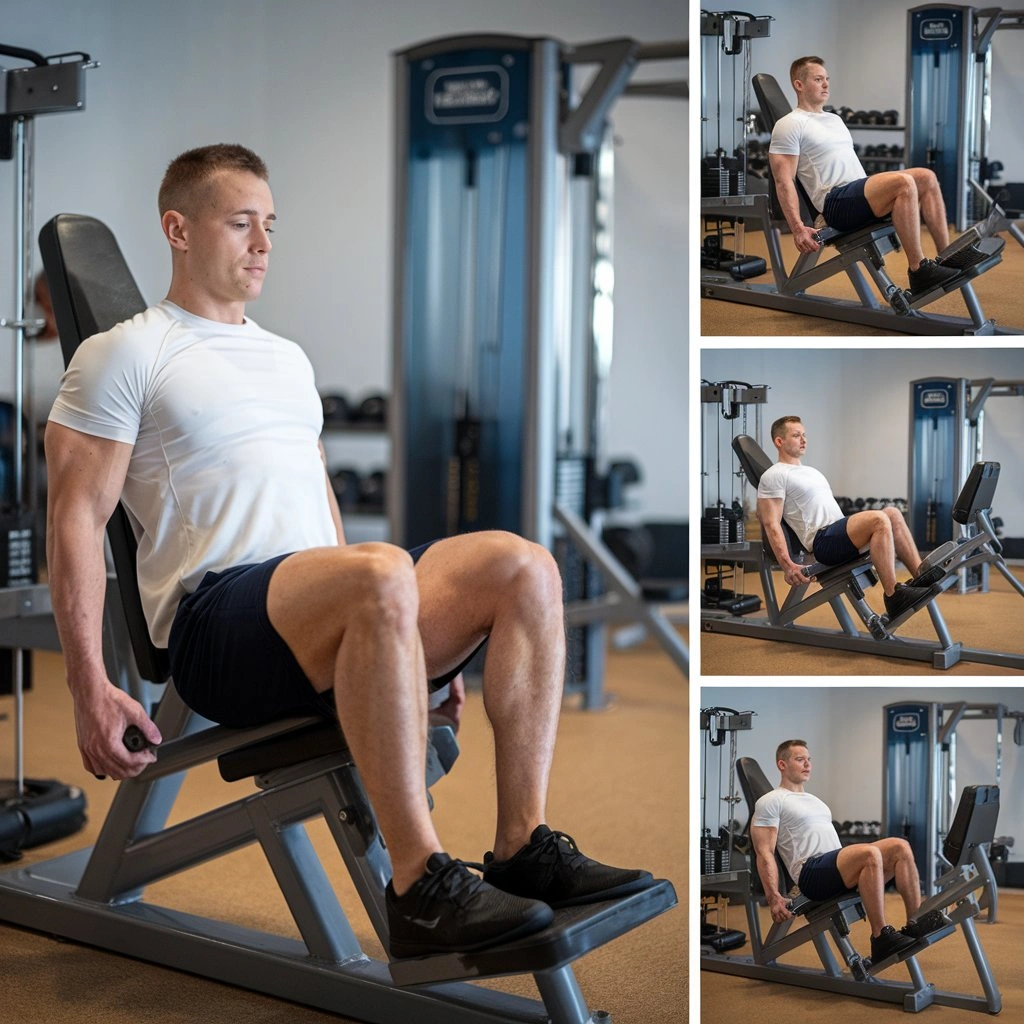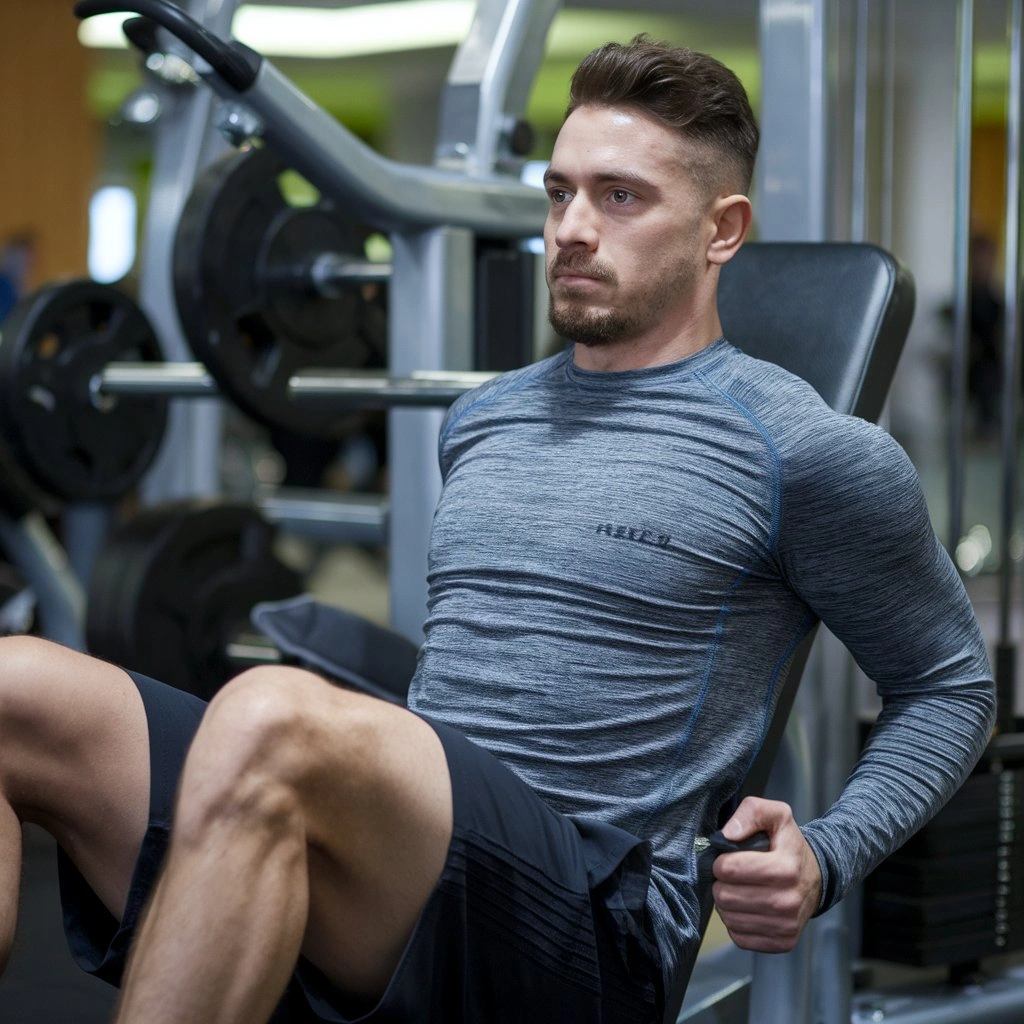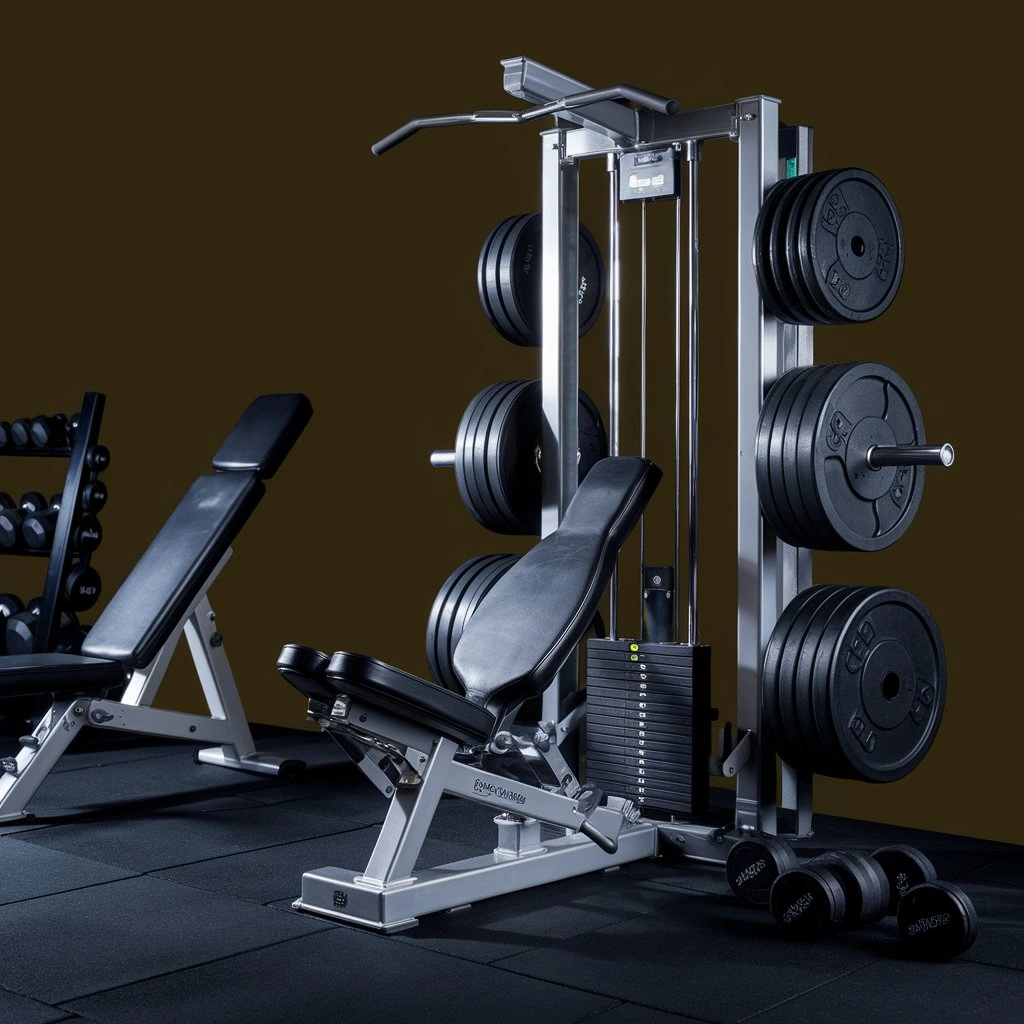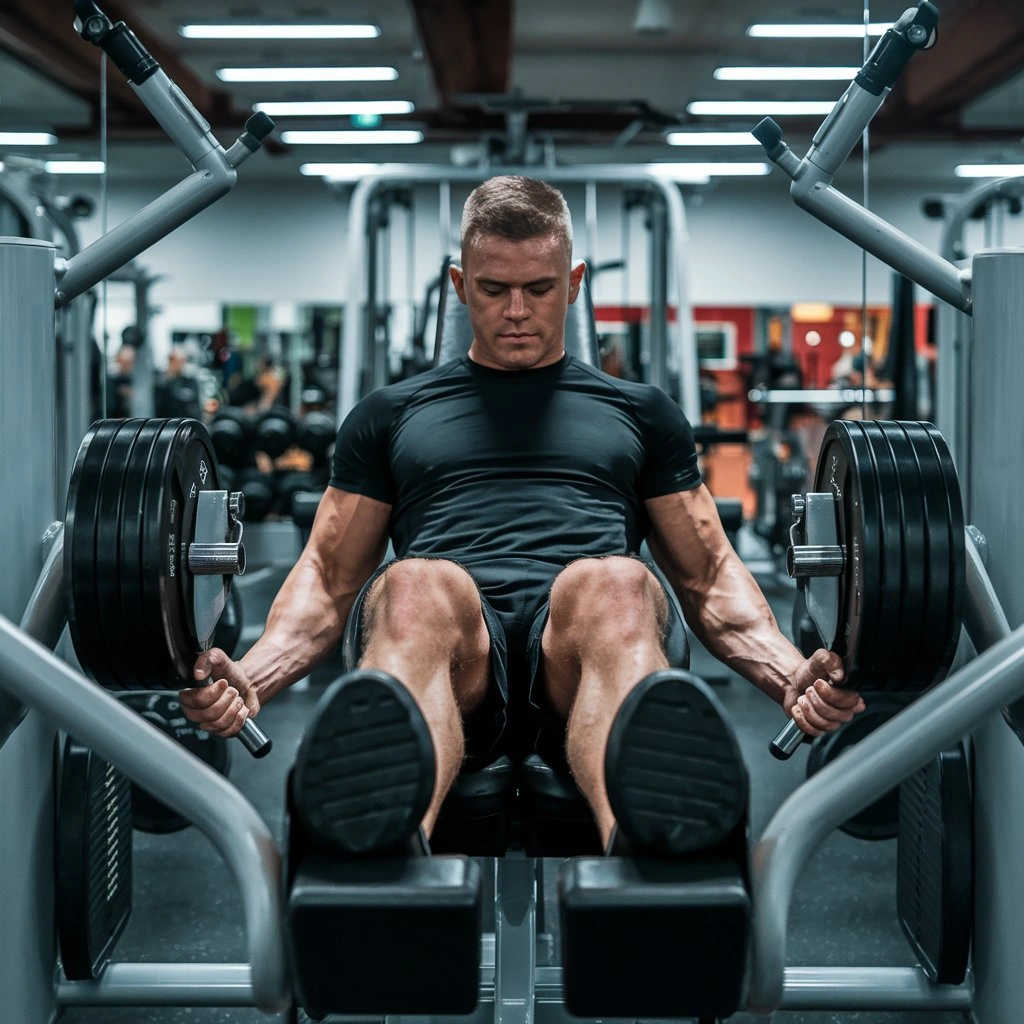Ever wonder about those cool gym machines where you sit down and push away with your legs? Those are leg press machines, a favorite for building strong, toned legs! Today, we’re diving into the world of leg presses, focusing on the vertical leg press machine.
Leg Press 101
 Imagine a chair with a platform for your feet instead of a seat. That’s the basic idea of a Leg Press Machine. You sit down, position your feet, and then press the platform away using the power of your legs. This exercise targets some of your biggest and most important muscles, like the quads (in the front of your thighs), hamstrings (in the back), and glutes (your butt!).
Imagine a chair with a platform for your feet instead of a seat. That’s the basic idea of a Leg Press Machine. You sit down, position your feet, and then press the platform away using the power of your legs. This exercise targets some of your biggest and most important muscles, like the quads (in the front of your thighs), hamstrings (in the back), and glutes (your butt!).
There are two main types of leg press machines
- Horizontal Leg Press: This is the most common type. You sit in a chair-like position and push the platform forward in a straight line.
- Vertical Leg Press: This is where things get interesting! We’ll explore this one in more detail in a moment.
Leg Press Machines are a great option for people of all fitness levels. Beginners can use lighter weights to get strong. Experienced gym-goers can crank up the weight for a tough challenge. They’re also good for anyone with balance issues or lower back problems. They offer more support than exercises like squats.
The Vertical Advantage
Now, let’s shift gears and focus on the Vertical Leg Press Machine. This machine is kind of like its horizontal cousin but with a twist (literally!). Here’s what sets it apart:
- Seated Position: Just like the horizontal version. You sit on a comfy chair with back support.
- Press upward, not straight out. Do it in a diagonal motion. This can feel more natural for some people and target slightly different muscles.
- Focus on Glutes. The leg press works for your glutes because it moves upward. Strong glutes are important for everything. They help with running, jumping, and climbing stairs.
Description of the Vertical Leg Press Machine
We got you pumped about the vertical leg press in the intro, now let’s take a closer look at this machine itself.
Built for Power
Imagine a sturdy metal frame with a padded seat that reclines at an angle. That’s the base of the vertical leg press. Here’s a breakdown of its key features:
- Padded Seat: This comfy backrest supports your upper body throughout the exercise.
- Some machines have an adjustable backrest. It lets you change the seat angle for a custom workout.
- Foot Platform: This wide platform is where you place your feet to push against the weight. It’s usually textured or grooved to prevent slipping.
- Weight Holders are metal bars on the machine’s sides. You add weight plates to them to make the machine harder.
- Most machines have safety features. They include safety catches. These let you stop the exercise in a controlled way.
The Power of the Press
So, how does this machine work? It’s quite simple
- Sit and Secure: Adjust the backrest if needed. Then, sit with your back supported. Secure your feet on the platform, shoulder-width apart.
- Lift-off: Unlock the weight by releasing the safety catches. push the platform upwards by extending your legs at the knees.
- Controlled Descent: Don’t let the weight fall back down! lower the platform back to the starting position, feeling the tension in your legs.
- Repeat and Refuel: Do your desired number of repetitions, then rest and repeat! Remember, proper form is key to avoiding injuries.
Muscle Magic
The vertical leg press is a champion for targeting some of your key leg muscles:
- Quads are the front thighs. They are powerhouse muscles. They do most of the work when you push.
- Glutes (Buttocks): This machine is great for sculpting and strengthening your glutes. It’s because of the upward pressure.
- Your hamstrings are at the back of your thighs. They are not the main focus, but they also get some activation during the exercise.
 Benefits of Using the Vertical Leg Press Machine
Benefits of Using the Vertical Leg Press Machine
We’ve explored what the vertical leg press machine is and how it works. Now, let’s delve into the many reasons why this machine can become your best friend for building strong, sculpted legs!
Building Block Buster
The vertical leg press is a fantastic tool for building lower body strength. Here’s how:
- Progressive Overload: You can gradually increase the weight you lift over time, which challenges your muscles to adapt and grow stronger.
- Isolation Power: Unlike exercises like squats that work for multiple muscle groups, the vertical leg press focuses primarily on your quads and glutes. This allows you to isolate and target these specific muscles for maximum strength gains.
Muscle Marvel
Get ready for some serious muscle development!
- Glute Glory: As mentioned before, the vertical leg press is a glute-building champion. Strong glutes are not just for aesthetics; they improve your power, stability, and athletic performance.
- Quad Gains: Don’t forget your quads! The pushing motion of the vertical leg press strengthens and defines the muscles in the front of your thighs.
- Hamstring Help: While not the main focus, your hamstrings also get some love during the exercise, contributing to overall leg development.
Safety First, Gains Always
The vertical leg press offers some advantages when it comes to safety and joint support:
- Back Support: Unlike squats, the vertical leg press machine provides back support, making it a good option for people with lower back problems or those new to leg exercises.
- Reduced Stress on Knees: Compared to exercises that put a lot of stress on your knees, like lunges, the vertical leg press offers a more controlled movement that can be easier on your joints.
Workout Wizz
The vertical leg press isn’t a one-trick pony! Here’s how it fits into your workout routine:
- Warming Up: Use lighter weights to warm up your legs before moving on to heavier compound exercises.
- Strength Training: Increase the weight for a challenging workout that builds muscle and strength.
- Finishing Touches: Use lighter weights and higher reps to target muscle fatigue and add a finishing touch to your leg workout.
Proper Technique and Safety Measures
The vertical leg press is a great addition to your leg day routine, but proper technique is key to maximizing results and avoiding injury. Let’s break down the steps for using this machine safely and effectively.
Posture Perfect
Good form is essential! Here’s how to position yourself for success
- Sit Tall: Adjust the backrest if needed, then sit comfortably with your back pressed firmly against the pad. Maintain a tall posture with your shoulders back and relaxed.
- Foot Placement: Place your feet flat on the platform, shoulder-width apart. You can experiment with slightly wider or narrower stances to target different leg muscles.
- Leg Alignment: Your knees should be bent at a 90-degree angle when your feet are flat on the platform. Avoid locking your knees at the top of the movement.
Machine Marvel
Before you start pressing, make sure the machine is set up correctly
- Adjust the Weight: Choose a weight that is challenging but allows you to maintain proper form throughout the entire set. Start lighter if you’re new to the exercise.
- Safety First: Engage the safety catches before lifting the weight. This allows you to stop the exercise in a controlled manner if needed.
- Range of Motion: Adjust the seat position if necessary to ensure a full range of motion without straining your knees.
Warm Up Wise
Never skip the warm-up! Here are some exercises to get your legs ready for the vertical leg press
- Light Cardio: Get your blood flowing with some light cardio like jumping jacks or jogging in place for a few minutes.
- Dynamic Stretches: Perform dynamic stretches like leg swings and lunges to prepare your muscles for movement.
- Light Leg Presses: Start with a very lightweight machine to warm up your quads, glutes, and hamstrings.
Safety Matters
Safety should always be your top priority. Here are some precautions to prevent injury
- No Ego Lifting: Don’t use a weight that is too heavy. You should be able to control the movement throughout the entire rep.
- Listen to Your Body: Stop the exercise if you feel any pain in your back, knees, or hips.
- Don’t Bounce: Avoid using momentum to lift the weight. Push the platform up with controlled leg strength.
- Spotter Safety: Consider having a spotter present, especially when using heavier weights. They can help you lift the weight off the safety catches and assist you if needed.
 Variations and Advanced Techniques
Variations and Advanced Techniques
Mastered the basic vertical leg press? Get ready to take your leg workouts to the next level with these variations and advanced techniques!
Single Leg Superstar
Challenge yourself and target your leg imbalances with the single-leg vertical leg press:
- One at a Time: Perform the exercise with one leg at a time instead of both legs together. This forces each leg to work independently, improving strength and stability.
- Start Lighter: Since you’re using only one leg, reduce the weight significantly compared to the standard two-leg press.
- Focus on Form: Maintain proper form throughout the movement, keeping your core engaged and your back pressed against the seat.
Resistance Boost
Want to add an extra layer of difficulty? Consider these options
- Resistance Band Bonanza: Loop a resistance band around the platform of the machine for added resistance throughout the pushing motion.
- Weight Plate Party: Hold a weight plate between your feet while performing the exercise. This increases the overall weight you’re pushing and challenges your core stability.
Explosive Edge
Ready for some explosive action? Plyometric movements can be incorporated with the vertical leg press for advanced users:
- Pre-load and Push: Add a weight that allows for a full range of motion. At the bottom of the movement, quickly push down slightly before explosively pressing the platform upwards.
- Box Jumps (careful!): For a more advanced plyometric variation, you can carefully step off the platform onto a sturdy box at the bottom of the movement and then jump explosively back onto the platform. Caution: This is an advanced move and requires proper form and a spotter for safety.
Advanced Training Tactics
Experienced lifters can explore these training protocols to push their limits
- Drop Sets: Perform a set with a heavy weight for a certain number of reps, then immediately reduce the weight and continue for another set with more reps. This technique helps fatigue your muscles for maximum growth.
- Supersets: Combine the vertical leg press with another leg exercise like leg extensions or hamstring curls for a superset. This keeps your workout intense and time-efficient.
Common Mistakes to Avoid
The vertical leg press can be a fantastic tool for building strong legs, but even the best tools can be misused. Here are some common mistakes to avoid so you can maximize your gains and minimize your risk of injury:
Weight Woes
- Ego Lifting: Packing on too much weight is a recipe for disaster. It compromises your form, increases stress on your joints, and can lead to injury. Choose a weight that allows you to maintain proper form throughout the entire set.
Form Faux Pas
- Slouching Savior: Don’t let your back become a rounded question mark! Sit tall with your shoulders back and core engaged throughout the exercise. This protects your spine and ensures maximum muscle activation.
- Knee Nuisances: Locking your knees at the top or hyperextending them at the bottom are both no-nos. Maintain a slight bend in your knees throughout the movement to protect your joints.
- Footloose and Fancy-Free: Don’t let your feet dangle off the platform or rest on your toes. Plant your feet flat and shoulder-width apart for better stability and control.
Warm-Up Woes
- Cold Turkey Presses: Skipping the warm-up is a surefire way to increase your risk of injury. Get your blood flowing and prepare your muscles with light cardio and dynamic stretches before diving into the vertical leg press.
Cool Down Catastrophe
- The Disappearing Act: Don’t just vanish after your last set! Finish your workout with some static stretches to improve flexibility and reduce muscle soreness.
Safety Slip-Ups
- Ignoring the Safety Catches: These are your friends, not decorations! Utilize the safety catches to prevent the weight from crushing you if you lose control.
- Going Solo: Especially when using heavy weights, consider having a spotter present to assist you and ensure safety.
- Bouncing for Bliss: Don’t use momentum to fling the weight around. Control the movement with your leg strength for maximum benefit and minimal risk.
 Sample Vertical Leg Press Workout Routine
Sample Vertical Leg Press Workout Routine
Ready to put your newfound vertical leg press knowledge into action? Here’s a sample workout routine that incorporates this machine for a powerful leg workout!
Warm Up Wise (5-10 minutes)
Don’t underestimate the warm-up! It primes your body for exercise and reduces your risk of injury. Here’s what to include:
- Light Cardio: Get your blood flowing with 5 minutes of light cardio like jumping jacks, jogging in place, or brisk walking.
- Dynamic Stretches: Loosen up your joints and prepare your muscles for movement with dynamic stretches like leg swings, lunges with arm circles, and high knees.
- Light Leg Presses: Perform a set of 10-15 repetitions with a very lightweight vertical leg press to warm up your quads, glutes, and hamstrings.
Main Workout (30-40 minutes)
This is where the magic happens! Here’s a breakdown of your main exercises
Vertical Leg Press (3 sets of 8-12 repetitions)
- This is your star exercise! Choose a weight that challenges you but allows you to maintain proper form throughout the set.
- Focus on a controlled movement, pushing the platform upwards with your legs and lowering it back down slowly.
Leg Extensions (3 sets of 10-15 repetitions)
- This exercise isolates and strengthens your quads (front thigh muscles).
- Adjust the machine so your knees are bent at a 90-degree angle and extend your legs straight out against resistance.
Hamstring Curls (3 sets of 10-15 repetitions)
- Don’t neglect your hamstrings! This exercise targets the back of your thighs.
- Sit on a hamstring curl machine and curl your heels towards your glutes, squeezing your hamstrings at the top of the movement.
Single-Leg Vertical Leg Press (Optional – 2 sets of 6-8 repetitions per leg)
- This is an advanced variation that challenges your balance and leg strength.
- Perform the vertical leg press with one leg at a time, focusing on proper form and stability.
Cool Down and Relax (5-10 minutes)
Don’t forget to cool down after your workout! This helps your body recover and reduces muscle soreness. Here’s what to do:
- Static Stretches: Hold static stretches for each major muscle group worked during your workout, like your quads, hamstrings, glutes, and calves, for 30 seconds each.
- Foam Rolling (Optional): Use a foam roller to target any tight spots or muscle tension.
- Relaxation Techniques: Take a few deep breaths and relax your muscles. You can even try some light meditation to wind down.
Conclusion
We’ve explored the vertical leg press machine from top to bottom, and hopefully, you’re now pumped to include it in your leg workouts! Here’s a quick recap of its benefits and features:
A Muscle-Building Powerhouse
- Targets key leg muscles like quads, glutes, and hamstrings for increased strength and development.
- Offers isolation benefits, allowing you to focus on specific muscle groups.
- Helps build lower body strength through progressive overload by gradually increasing weight.
Safety and Support
- Provides back support, making it suitable for beginners or those with lower back issues.
- Offers a controlled movement that can be easier on your knees compared to some other leg exercises.
- Safety catches allow for a controlled stop in case you lose control of the weight.
A Versatile Workout Tool
- It can be used for various purposes, including warm-up sets, main strength training exercises, and even finishing touches to target muscle fatigue.
- It offers variations like the single-leg press for advanced users or those wanting to address leg imbalances.
- Compatible with additional resistance like weight plates or bands for an extra challenge.
The All-Around Leg Day Hero
The vertical leg press machine is a fantastic addition to your workout routine, regardless of your fitness level. It’s a safe, effective way to build strength, sculpt muscle, and add variety to your leg workouts.
Embrace the Challenge!
Don’t be afraid to experiment with the vertical leg press. Start with proper form and a weight that allows you to maintain control throughout the movement. As you get stronger, you can increase the weight, explore Different Variations, and incorporate it into a well-rounded leg workout routine.
The vertical leg press machine is a versatile and effective tool waiting to be explored. So, next time you hit the gym, give it a try and see how it can help you achieve your fitness goals and build those strong, sculpted legs you’ve been dreaming of!

